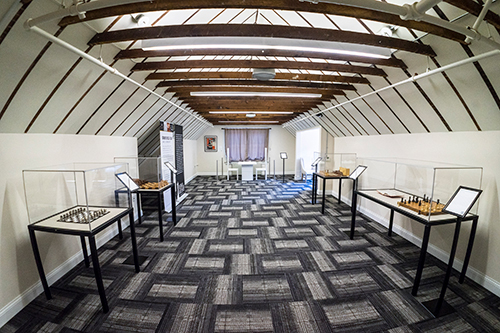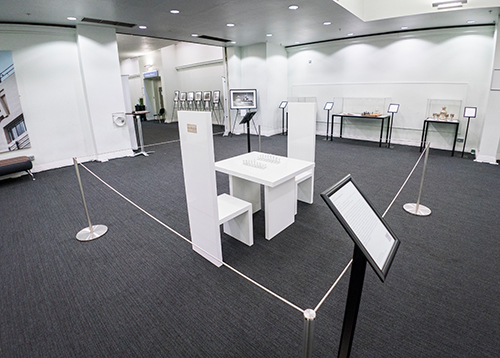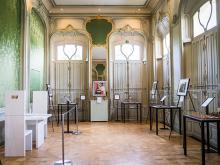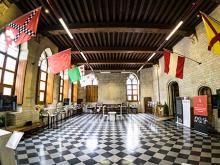Artifacts Featured in the Exhibition
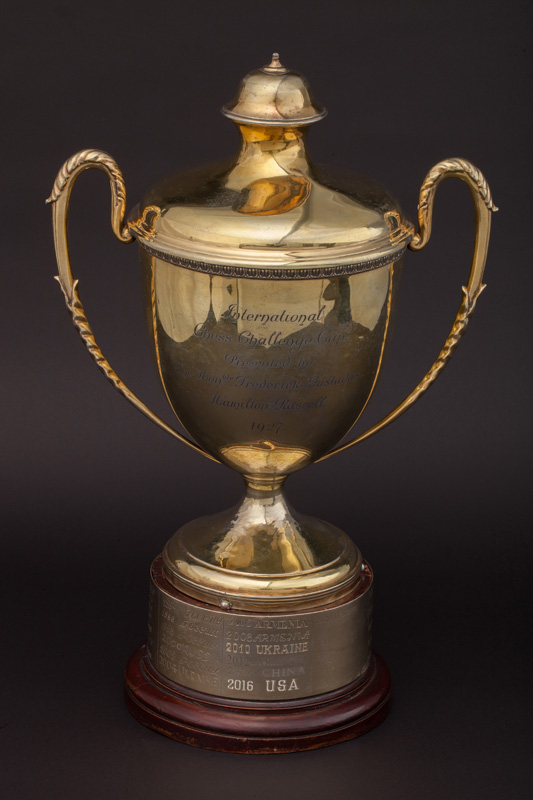
London, England
Nayler Brothers
Hamilton-Russell Cup
1927
19 x 12 ½ x 8 ½ in.
Gilt silver and mahogany
Collection of the Fédération Internationale des Échecs
Created in 1927 and presented to the World Chess Federation (Fédération Internationale des Échecs or FIDE) by Frederick Gustavus Hamilton-Russell, this trophy celebrates the accomplishments of the winning teams in the open section of the Chess Olympiad. Teams from around the world compete in the biennial tournament, and the first-place team takes custody of this trophy until the next Olympiad. The trophy’s base displays the names of the winning teams. The Hamilton-Russell Cup is currently in the care of the World Chess Hall of Fame and US Chess due to the victory of the American team in the open section of the 2016 Chess Olympiad, which was held in Baku, Azerbaijan, from September 1 to 14, 2016. The American team included Grandmasters Fabiano Caruana, Hikaru Nakamura, Ray Robson, Sam Shankland, and Wesley So. International Master John Donaldson served as team captain and Grandmaster Aleksandr Lenderman served as team coach. Caruana, Nakamura, and So are participating in the 2017 Grand Chess Tour.
Not on view during the London Chess Classic.
Londres, Angleterre
Les frères Nayler
Hamilton-Russel Cup
1927
48,25 cm x 31,75 x 21,5 cm
Plaqué argent et bois d’acajou
Collection de la Fédération Internationale des Échecs
Crée en 1927 et offerte à la Fédération Internationale des Échecs (Fédération Internationale des Échecs ou FIDE) par Frederick Gustavus Hamilton-Russell, ce trophée célèbre les performances des équipes gagnantes dans la section ouverte de l'Olympiade d'Échecs. Des équipes du monde entier participent à ce tournoi biannuel et l'équipe ayant obtenue la première place conserve la garde de ce trophée jusqu'à la prochaine Olympiade. La base du trophée affiche le nom des équipe gagnantes. La Coupe Hamilton-Russell est pour le moment la possession de la World Chess Hall of Fame et de l’US Chess en raison de la victoire de l'équipe américaine dans la section ouverte de l’Olympiade d'échecs de 2016 qui s’est déroulé à Bakou, en Azerbaïdjan, du 1er au 14 septembre 2016. L'équipe américaine était composée des grands maîtres des échecs Fabiano Caruana, Hikaru Nakamura, Ray Robson, Sam Shankland et Wesley So. Ainsi que par John Donaldson désigné comme capitaine de l'équipe et le grand maître Aleksandr Lenderman a été entraîneur de l'équipe. Fabiano Caruana, Hikaru Nakamura et Wesley So participent au Grand Chess Tour de 2017.
Londen, Engeland
Nayler Brothers
Hamilton-Russell Cup
1927
19 x 12 ½ x 8 ½ inch (48,25 cm x 31,75 x 21,5 cm)
Verguld zilver en mahoniehout
Collectie van de Federatie Internationale des Échecs
De trofee is gemaakt in 1927 en aangeboden aan de Wereld Schaak Federatie (Fédération Internationale des Échecs of FIDE) door Frederick Gustavus Hamilton-Russell. De wisselbeker vereert de prestaties van de winnende teams in de open sectie van de schaakolympiade. Teams van over de hele wereld participeren aan het tweejaarlijkse toernooi, en het winnende team ontvangt de trofee en houdt deze in beheer tot aan het begin van de volgende Olympiade. De voet van de trofee toont de namen van de winnende teams. De Hamilton-Russell Cup is momenteel in de beheer van de World Chess Hall of Fame en US Chess dankzij de overwinning van het Amerikaanse team in de open sectie van de schaakolympiade 2016, dat van 1 t/m 14 september 2016 in Baku, Azerbeidzjan werd gehouden. Het Amerikaanse team bestond uit de grootmeesters Fabiano Caruana, Hikaru Nakamura, Ray Robson, Sam Shankland en Wesley So. Internationaal Meester John Donaldson was de teamleider en Grootmeester Aleksandr Lenderman diende als teamcoach. Caruana, Nakamura en So nemen deel aan de Grand Chess Tour 2017.
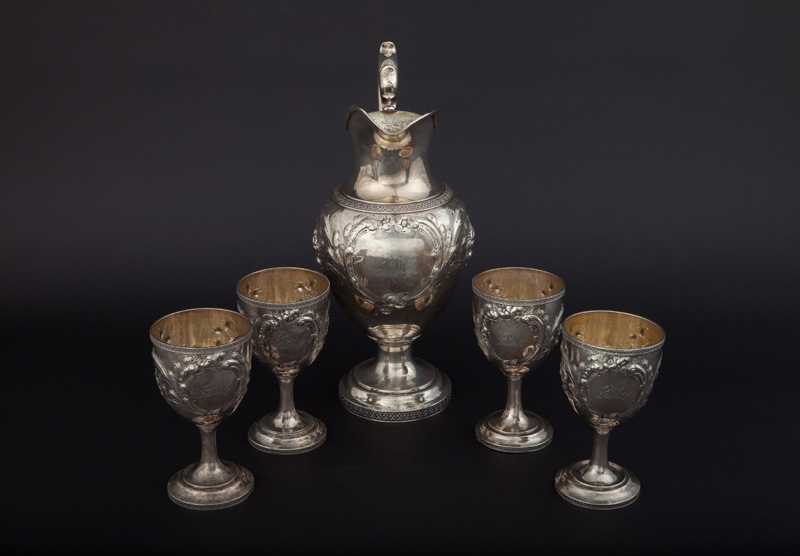
New York
Ball, Black, & Co. and Eoff & Sheppard
Paul Morphy Silver Service
1857
Goblets: 6 ½ x 3 ⅛ in. dia. (base)
Pitcher: 12 ¾ x 4 ½ in. dia. (base)
Coin silver
Collection of the U.S. Chess Trust
Paul Morphy (1837-1884), a lifelong resident of New Orleans, Louisiana, is often called the “pride and sorrow of chess.” He was arguably the best player in the world, but he retired at the peak of his talent after an active career lasting only a few years (1857-1860). This coin silver beverage set was presented to Paul Morphy for winning the first American Chess Congress, which was held in New York City in 1857. His good friend Judge Edward Bermudez inherited the set after Morphy’s death. It subsequently passed through several hands before it came to be owned by a French family in Louisiana, who sold them to the U.S. Chess Trust in 1986. The matching salver or tray—engraved with a picture of Morphy playing against Louis Paulsen—remains in a private collection. A lawyer by trade and a well-educated gentleman in his own eyes, Morphy viewed chess as an amateur rather than a professional pursuit, and in accordance with this belief would not accept a cash prize for his victory. Consequently, the tournament organizers presented him with this silver set costing USD $300 (today USD $8100), the exact amount of the tournament’s first-place cash prize.
New York 1857
Ball, Black, & Co. and Eoff & Sheppard
Paul Morphy service à verres et carafe en argent
Verres : 16,5 cm x 8 cm (base) (16,5 cm x 8 cm)
Carafe : 32,4 cm x 11,4 cm (base) (32,4 cm x 11,4 cm)
Pièce en argent
Collection du U.S. Chess Trust
Paul Morphy (1837-1884), un résident de longue date de la Nouvelle-Orléans, en Louisiane, est souvent appelé «la fierté et le chagrin des échecs». Il était sans doute le meilleur joueur du monde d’échecs, mais il s'est retiré au sommet de son talent après une courte carrière qui ne dura que quelques années (1857-1860). Ce service à boisson en argent a été offerte à Paul Morphy pour avoir remporté le premier Congrès américain d'échecs (The American Chess Congress) , qui a eu lieu à New York en 1857. Le juge Edward Bermúdez, grand ami de Morphy, a hérité du set après la mort de celui-ci. Le service est par la suite passé dans plusieurs mains avant qu'il ne devienne la propriété d’une famille française en Louisiane, qui les a vendus au US Chess Trust en 1986. Le plateau ou plaque assorti(e) -gravé(e) avec une photo de Morphy jouant contre Louis Paulsen- reste dans une collection privée. Avocat de profession et se définissant lui même comme un gentleman bien éduqué, Morphy considérait les échecs comme un passe-temps plutôt qu'une activité professionnelle et, conformément à cette croyance, il refusa le prix en espèces pour sa victoire. Aussi, les organisateurs du tournoi lui présentèrent ce service d'argent coûtant USD $ 300 (aujourd'hui USD $ 8100), le montant exact du prix en espèces du premier tour du tournoi.
New York
Ball, Black, & Co. and Eoff & Sheppard
Paul Morphy's zilveren servies
1857
Beker: 6 ½ x 3 ⅛ inch diameter (voet)
Karaf: 12 ¾ x 4 ½ inch diameter (voet)
Zilveren munt
Collectie van de U.S. Chess Trust
Paul Morphy (1837-1884), woonde zijn hele leven in New Orleans, Louisiana, en wordt vaak de "trots en verdriet van het schaken" genoemd. Hij was zonder twijfel de beste speler ter wereld, maar trok zich terug uit het schaken op het hoogtepunt van zijn talent na een actieve carrière die slechts een paar jaar duurde (1857-1860). Deze muntsilveren drankset werd aangeboden aan Paul Morphy voor zijn toernooioverwinning in het eerste American Chess Congress, dat in 1857 in New York werd gehouden. Zijn goede vriend Judge Edward Bermudez erfde de set na Morphy's dood. Vervolgens ging over naar verschillende eigenaren voordat het eigendom werd van een Franse familie in Louisiana, die het in 1986 verkocht aan de U.S. Chess Trust. Het bijbehorende dienstblad, gegraveerd met een foto van Morphy die tegen Louis Paulsen speelt, blijft in een privécollectie. Als een advocaat handelsrecht en een in zijn eigen ogen hooggeschoolde heer, zag Morphy schaken als een hobby in plaats van een professionele beoefening. In overeenstemming met deze overtuiging accepteerde hij geen geldprijs voor zijn toernooioverwinning. Daarom presenteerden de toernooi-organisatoren hem deze zilveren set ter waarde van $300 (tegenwoordig $8.100), het exacte bedrag van de geldprijs die toebehoorde aan de eerste prijs van het toernooi.
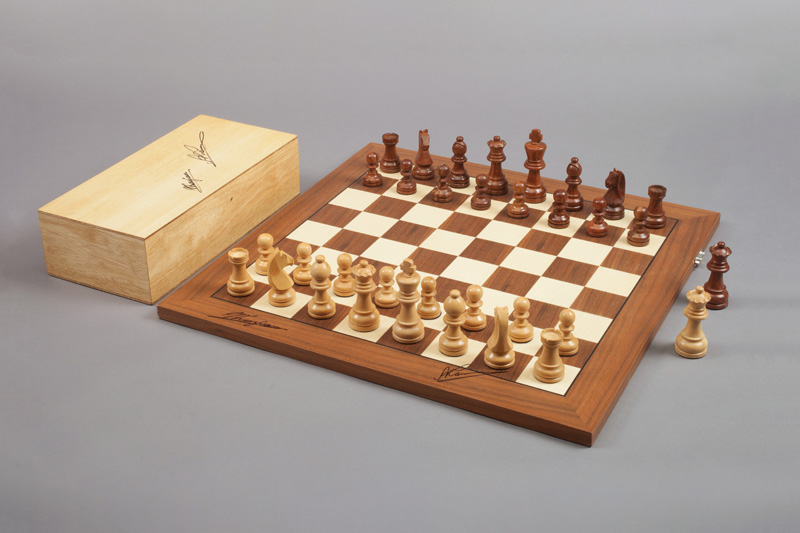
Chess Set, Board, and Box from the 2002 New York, New York, Garry Kasparov vs. Anatoly Karpov Exhibition Match
December 19-20, 2002
King height: 3 3⁄4 in.
Board: 20 7∕8 x 20 7∕8 in.
Box: 13 1⁄4 x 6 1⁄2 x 3 1⁄2 in.
Chess set, board, and box
Gift of Arnold H. Garcia
World Chess Champions Garry Kasparov and Anatoly Karpov used this equipment in a two-day exhibition match (X3D World Chess Match) in ABC (American Broadcasting Corporation) Studios. X3D Technologies, a producer of three-dimensional viewing equipment, sponsored the event and encouraged spectators who owned a special viewer to watch the event in 3D from the comfort of their homes.
In the match, Karpov and Kasparov played two games of rapid chess per day. Karpov, who had not defeated Kasparov in a game since 1990, won the match by a score of 2.5-1.5, a result that surprised many viewers including chess champion and author Jennifer Shahade. In a December 21, 2002, article in the New York Times, she said, “Karpov’s victory is shocking. Garry has an aura of invincibility about him, and even when the last game was petering out to a draw, you expected him to somehow magically turn the game in his favor.” The match was the first in which Karpov triumphed over Kasparov.
Pièces d'échecs, plateau et boîte de rangement 2002 New York, New York Garry Kasparov contre Anatoly Karpov exposition du match
19-20 décembre 2002
Hauteur du Roi : 3 3/4 (9,5 cm)
Plateau : 20 7/8 x 20 7/8 (53 cm x 53 cm )
Boîte de rangement : 13 1/4 x 6 1/2 x 3 1/2 in. (33,75 cm x 16,5 cm x 9,25 cm)
Set de pièces de jeu, plateau et Boîte de rangement d'Arnold H. Garcia
Les champions mondiaux d'échecs Garry Kasparov et Anatoly Karpov ont utilisé cet échiquier dans un match d'exposition de deux jours (X3D World Chess Match) dans les studios ABC (American Broadcasting Corporation). X3D Technologies, un producteur de matériel de visionnement tridimensionnel, a parrainé l'événement et a encouragé les spectateurs qui possédaient une visionneuse spéciale à regarder l'événement en 3D dans le confort de leurs maisons. Dans le match, Karpov et Kasparov ont joué deux jeux d'échecs rapides par jour. Karpov, qui n'a pas vaincu Kasparov dans un match depuis 1990, a remporté le match d'un score de 2,5-1,5, ce qui a surpris de nombreux spectateurs, y compris la championne d'échecs et l'auteur Jennifer Shahade. Dans un article du 21 décembre 2002 dans le New York Times, elle a déclaré: "La victoire de Karpov est surprenante. Garry a une aura d'invincibilité à son sujet, et même lorsque le dernier match a été désigné par un tirage au sort, on s’attendez à ce qu'il fasse pencher comme par magie le jeu en sa faveur. "Le match a été le premier dans lequel Karpov a triomphé de Kasparov.
Schaakspel, Bord en Doos van de demonstratietweekamp tussen Garry Kasparov en Anatoly Karpov in 2002 te New York, New York
19-20 december 2002
Koningshoogte: 3 3/4 inch
Bord: 20 7/8 x 20 7/8 inch
Doos: 13 1/4 x 6 1/2 x 3 1/2 inch
Schaakstel, bord en doos
Gift van Arnold H. Garcia
Wereldschaakkampioenen Garry Kasparov en Anatoly Karpov gebruikten dit spel in een tweedaagse demonstratiewedstrijd (X3D World Chess Match) in de studio's van ABC (American Broadcasting Corporation). X3D Technologies, een producent van driedimensionale kijkapparatuur, sponsorde het evenement en moedigde toeschouwers aan die een speciale kijker bezaten om het evenement in 3D te thuis te volgen. In de tweekamp speelden Karpov en Kasparov twee rapid partijen per dag. Karpov, die Kasparov sinds 1990 niet had verslagen, won de match met een score van 2.5-1.5, een resultaat dat veel kijkers, waaronder schaakkampioen en schrijfster Jennifer Shahade, verraste. In een artikel op 21 december 2002 schreef ze: "Karpov's overwinning is schokkend. Garry heeft een aura van onoverwinnelijkheid om zich heen, en zelfs wanneer de laatste partij op een remise leek uit te komen, verwachtte je dat hij op een of andere manier de partij in zijn voordeel zou beslechten." Het was de eerste tweekamp waarin Karpov Kasparov wist te verslaan.
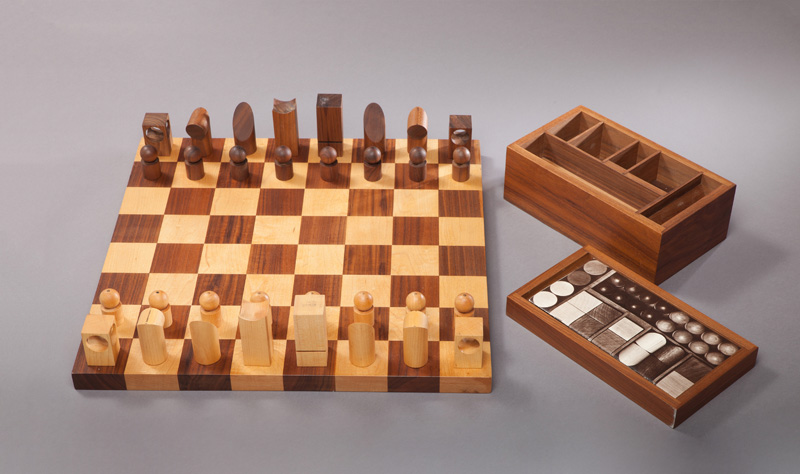
Robert Rudolph Hollendonner
Hollendonner Chessmen
1978
King size: 3 1/16 in.
Board: 18 x 18 in.
Box: 4 ½ x 9 13/16 x 5 ½ in.
Maple, walnut
Collection of the World Chess Hall of Fame, gift of Raquel Browne (wife of Walter Browne)
Architect Robert Rudolph Hollendonner created this modern set with the intention of challenging the dominance of traditional Staunton chess sets in tournament settings. Each handmade piece was created using a system of spheres and squares, which were arranged in ways that allude to the pieces’ movements and meanings. To Hollendonner, the circle represented the divine while the solidity of the square symbolized wisdom, construction, and dwellings. The unconventional set once belonged to 2003 U.S. Chess Hall of Fame inductee Grandmaster Walter Browne (1949-2015). Browne was a dominant force in American chess and won six U.S. Chess Championships (1974, 1975, 1977, 1980, 1981, 1983). He excelled in open tournaments, earning shared or outright first place in the American Open seven times, the National Open eleven times, the U.S. Open three times, and the World Open three times. This chess set is part of a generous gift of photographs, periodicals, and other archival materials from the estate of Walter Browne.
Robert Rudolph Hollendonner
Hollendonner Chessmen
1978
Hauteur du roi : 3 1/16 in. (7,75 cm)
Échiquier: 18 x 18 in. (45,75 cm x 45,75 cm)
Boîte: 4 ½ x 9 13/16 x 5 ½ in. (11,5 cm x 25 cm x 14 cm)
Érable, noyer
Collection de la World Chess Hall of Fame, don de Raquel Browne (épouse de Walter Browne)
Architecte Robert Rudolph Hollendonner a créé cet échiquier moderne dans le but de remettre en cause la domination des échecs traditionnels de Staunton dans les paramètres du tournoi. Chaque pièce a été faite à la main a été créée à l'aide d'un ensemble de sphères et de carrés, qui ont été conçus de manière à faire allusion aux actions et aux significations de chaque pièce. Pour Hollendonner, le cercle représentait le divin tandis que la solidité du carré symbolisait la sagesse et les constructions humaines. Cet échiquier original a appartenu jusqu’en 2003 au grand-maître des échecs Walter Browne (1949-2015) intronisé par le U.S. Chess Hall of Fame. Browne était une force majeure dans les échecs américains et a remporté six Championnats américains d'échecs (1974, 1975, 1977, 1980, 1981, 1983). Il a excellé dans les tournois ouverts, gagnant la première place partagée ou absolue à l'US Open sept fois, l'Open national onze fois, les Etats-Unis Open trois fois et l'Open World trois fois. Cet ensemble d'échecs fait partie d'un généreux don de photographies, de journaux et d'autres documents d'archives de la collection de Walter Browne.
Robert Rudolph Hollendonner
Hollendonner Schaakspel
1978
Koningshoogte: 3 1/16 inch
Bord: 18 x 18 inch
Doos: 4 ½ x 9 13/16 x 5 ½ inch
Esdoorn, walnoot
Collectie van de World Chess Hall of Fame, geschenk van Raquel Browne (vrouw van Walter Browne)
Architect Robert Rudolph Hollendonner maakte dit moderne schaakspel met als doel om de dominantie van de traditionele Staunton-schaakstukken in toernooien te betwisten. Elk handgemaakt schaakstuk werd vervaardigd met behulp van een combinatie van van bollen en vierkanten, die op zo'n manier zijn gerealiseerd dat het de bewegingen en betekenissen van de schaakstukken aanduidden. Voor Hollendonner vertegenwoordigde de cirkel het goddelijke, terwijl de hechtheid van het vierkant symbool stond voor wijsheid, constructie en onderkomen. Het baanbrekende schaakspel behoorde ooit tot de in 2003 in de U.S. Chess Hall of Fame ingewijde Grootmeester Walter Browne (1949-2015). Browne was een dominante kracht in het Amerikaanse schaken en won zes US Chess Championships (1974, 1975, 1977, 1980, 1981, 1983). Hij excelleerde in open toernooien, waaronder zeven gedeelde of ongedeelde titels in de American Open, elfmaal de National Open, driemaal de American Open en driemaal de World Open. Dit schaakspel is onderdeel van een royale gift van foto's, tijdschriften en andere archiefmateriaal uit het landgoed van Walter Browne.
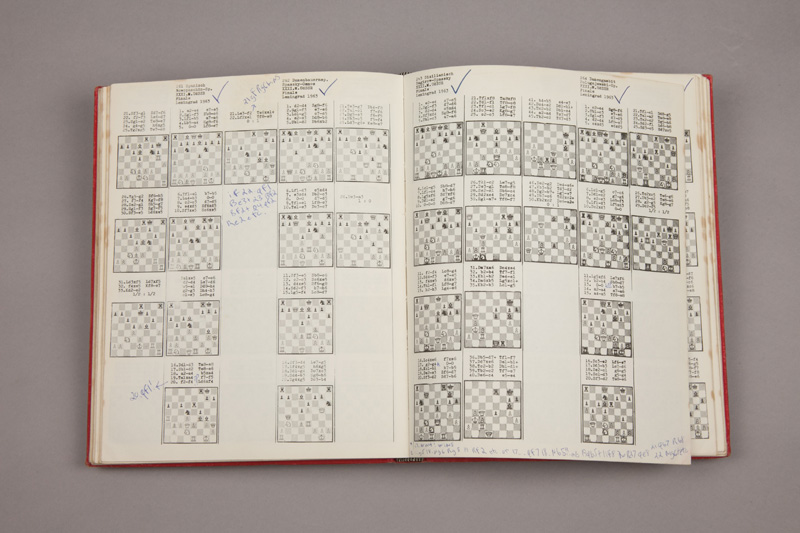
Eduard Wildhagen
Weltgeschichte des Schachs Lieferung 27, Boris Spassky: 355 Partien
(History of Chess Part 27, Boris Spassky: 355 Matches)
1972
13/16 x 8 ¾ x 7 in.
Book
Collection of Dr. Jeanne and Rex Sinquefield
Robert “Bobby” Fischer (1943-2008) is said to have memorized each of the 355 games in this volume, which totaled over 14,000 moves. The book was a key aid in his preparations for Fischer’s 1972 World Chess Championship match against Boris Spassky (b. 1937). The last volume in a series of books produced by the German publisher Eduard Wildhagen on great players of the world, it contains unannotated games by Spassky, with a diagram illustrating the progress of the game every five moves. This copy includes handwritten notes from Fischer, analyzing Spassky’s games.
Eduard Wildhagen
Weltgeschichte des Schachs Lieferung 27, Boris Spassky: 355 Partien (Histoire de l'échec Partie 27, Boris Spassky: 355 Matchs)
1972
13/16 x 8 ¾ x 7 in. (2 cm x 22,25 cm x 17,75 cm)
Livre
Collection de Dr. Jeanne et Rex Sinquefield
Robert "Bobby" Fischer (1943-2008) aurait mémorisé chacun des 355 jeux dans ce volume, qui totalise à lui seul plus de 14 000 mouvements. Le livre a été d’une aide précieuse lors des préparatifs pour le match du Championnat du monde d'échecs de 1972 de Fischer contre Boris Spassky (né en 1937). Ce dernier volume de la série de livres produites par l'éditeur allemand Eduard Wildhagen sur les grands joueurs du monde, contient les jeux non traduit de Spassky, avec un diagramme illustrant la progression du jeu tous les cinq mouvements. Cette copie comprend des notes manuscrites de Fischer, analysant les jeux de Spassky.
Eduard Wildhagen
Weltgeschichte des Schachs Lieferung 27, Boris Spassky: 355 Partien (Schaakgeschiedenis Deel 27, Boris Spassky: 355 Partijen)
1972
13/16 x 8 ¾ x 7 inch.
Boek
Collectie van Dr. Jeanne en Rex Sinquefield
Over Robert "Bobby" Fischer (1943-2008) werd gezegd dat hij alle 355 partijen in deze volume, die meer dan 14.000 schaakzetten omvat, zou hebben onthouden. Het boek was een belangrijke hulp in de voorbereidingen op zijn WK-tweekamp tegen Boris Spassky (1937) in 1972. Het is de laatste volume in een serie boeken die door de Duitse uitgever Eduard Wildhagen over de sterkste spelers van de wereld werd geproduceerd, en het bevat onbecommentarieerde partijen van Spassky, met een diagramstelling voor iedere vijfde zet in de partij. Dit exemplaar bevat handgeschreven notities van Fischer, die Spassky's partijen analyseert.
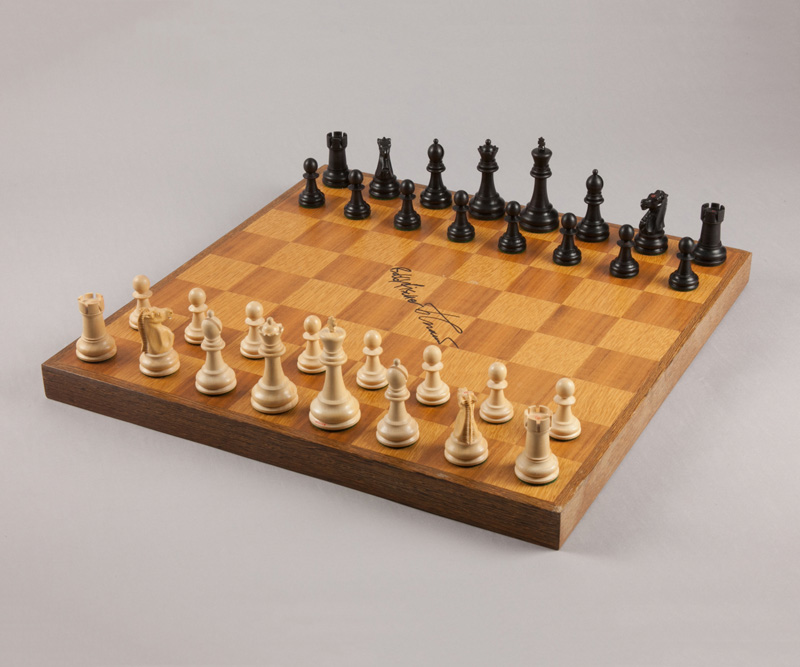
Chess Pieces from Game 3 of the 1972 World Chess Championship and Chessboard Signed by Bobby Fischer and Boris Spassky
1972
King size: 3 5/8 inches
Board: 1 ¼ x 19 x 18 ½ in.
Wood
Collection of Dr. Jeanne and Rex Sinquefield
These chess pieces bear witness to one of the most important games in the most famous World Chess Championship match—Bobby Fischer’s game 3 defeat of reigning World Chess Champion Boris Spassky. Had Fischer, trailing 0-2, lost game 3 of the World Chess Championship, it is speculated he may have quit the match entirely. Prior to this game Fischer had not beaten Spassky and his lifetime score, excluding the second game forfeit, was four losses and two draws in six games. Fischer used an unconventional strategy that worked, and he ultimately won the game, turning the tide of the 1972 match. The pieces are set to display a position from the third game of the match, when Fischer played this surprising move. The set is paired with a board signed by Bobby Fischer and Boris Spassky, which was made for the 1972 World Chess Championship match, but not used in the event.
Pièces d'échecs et échiquier du jeu 3 du World Chess Championship de 1972 signé par Bobby Fischer et Boris Spassky
1972
Hauteur du roi : 3 5/8 pouces (9,25 cm)
Échiquier : 1 ¼ x 19 x 18 ½ in. (3,25 cm x 48,25 cm x 47 cm)
Bois
Collection du Dr. Jeanne et Rex Sinquefield
Ces pièces d'échecs témoignent de l'un des jeux les plus importants dans le match du Championnat du Monde d'Échecs le plus célèbre: la défaite du match 3 de Bobby Fischer contre le Champion mondial d'échecs Boris Spassky. Si Fischer, derrière 0-2, a perdu le jeu 3 du World Chess Championship, il a spéculé qu'il aurait peut-être quitté complètement le match. Avant ce jeu, Fischer n'avait pas battu Spassky et son score à vie, à l'exception du deuxième match perdu, était de quatre défaites et deux tirages en six matchs. Fischer a utilisé une stratégie non conventionnelle qui a fonctionné, et il a finalement gagné le jeu, tournant la marge du match de 1972. Les pièces sont destinées à afficher une position du troisième match du match, lorsque Fischer a joué ce mouvement surprenant. L'ensemble est jumelé à un panneau signé par Bobby Fischer et Boris Spassky, qui a été fait pour le match du Championnat du monde d'échecs de 1972, Mais pas utilisé dans l'événement.
Schaakstukken uit partij 3 van het wereldkampioenschap 1972 en het schaakbord ondertekend door Bobby Fischer en Boris Spassky
1972
Koningshoogte: 3 5/8 inches
Bord: 1 ¼ x 19 x 18 ½ inch
Hout
Collectie van Dr. Jeanne en Rex Sinquefield
Deze schaakstukken waren getuigen van een van de belangrijkste partijen in de beroemdste wereldkampioenschapswedstrijd ooit: Bobby Fischer's winst op Boris Spassky in de 3e partij van de match. Er werd gespeculeerd dat als Fischer, al op een 0-2 achterstand, deze 3e partij van het wereldkampioenschap ook zou hebben verloren, dat Fischer dan de match vroegtijdig zou hebben beëindigd. Voorafgaand aan deze partij had Fischer nog nooit van Spassky gewonnen en zijn levenslange score, met uitzondering van de tweede matchwedstrijd waar Fischer niet kwam opdagen, bedroeg vier verliespartijen en twee remises uit zes partijen. Fischer gebruikte in de 3e partij een onconventionele strategie die goed werkte en won uiteindelijk de partij, en kantelde daarmee de tweekamp. De stukken staan in de stelling van de 3e partij waarin Fischer de verrassende zet speelde. Het schaakspel hoort bij een door Bobby Fischer en Boris Spassky ondertekend bord dat speciaal voor de tweekamp werd gemaakt, maar niet is gebruikt tijdens de match in 1972.
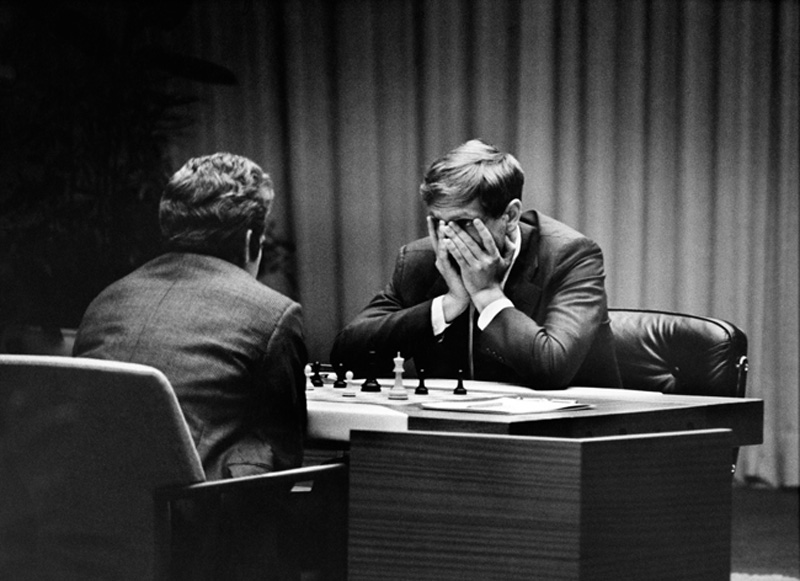
Harry Benson
Fischer vs. Spassky, Game One, Iceland
1972
19 x 28 ½ in.
Photograph
Collection of Dr. Jeanne and Rex Sinquefield
© Harry Benson
The tales of the 1972 World Chess Championship in Reykjavík, Iceland, are numerous and fantastic. Grandmaster Bobby Fischer arrived late to the first game, forfeited game two, inspected television cameras and lights, insisting that they were making too much noise or contained devices that were intended to distract him, and had special chess boards created for the match. He made outrageous demands—requesting more money than the agreed-upon prize fund of $125,000, and requiring that Game 3 be played in a “back room.” Much speculation surrounded this behavior and it was debated if this was “normal” Fischer conduct, or if he was intentionally attempting to cause a psychological breakdown of his opponent.
Fischer contre Spassky, Game One, Islande
1972
19 x 28 ½ in. (48,25 cm x 72,5 cm)
Photographie
Collection du Dr. Jeanne et Rex Sinquefield
© Harry Benson
Les anecdotes du Championnat du monde d'échecs de 1972 à Reykjavík, en Islande, sont nombreuses et fantastiques. Le grand maître Bobby Fischer est arrivé en retard au premier match, perdant des deux manches, il inspecta des caméras de télévision, des lumières, et les plateaux de jeu fabriqué spécialement pour l'événement en insistant sur le fait qu'ils fabriquaient trop de bruit ou contenait des dispositifs destinés à le distraire. Durant le championnat, Il a fait des demandes scandaleuses - en demandant plus d'argent que la valeur du prix de ce tournoi convenu de 125000 $- , et exigea que le jeu 3 soit joué dans les coulisses. Beaucoup de spéculations et de débats ont entouré ce comportement, Certains pensaient que c’était le comportement « normal » de Fischer et d’autres pensaient que Fischer tenter par tous les moyens de déstabiliser psychologiquement son adversaire.
Harry Benson
Fischer vs Spassky, Eerste Partij, IJsland
1972
19 x 28 ½ inch
Foto
Collectie van Dr. Jeanne en Rex Sinquefield
© Harry Benson
De verhalen over het Wereldkampioenschap Schaken van 1972 in Reykjavik, IJsland, zijn talrijk en fantastisch. Grootmeester Bobby Fischer arriveerde laat voor de eerste wedstrijd, kwam niet opdagen voor de tweede partij, inspecteerde televisiecamera's en lichten, drong er op aan dat ze teveel geluid maakte of ingebouwde apparatuur bevatte dat hem afleidde, en er waren speciale schaakborden gemaakt voor de tweekamp. Hij had verregaande eisen gesteld - zoals meer geld vragen dan het eerst overeengekomen prijsfonds van $ 125.000 en hij eiste dat Partij 3 in een "achterkamer" werd gespeeld. Dit gedrag was met veel speculatie onderheven en er werd gedebatteerd of dat "normaal" Fischer-gedrag was of dat hij opzettelijk probeerde om grote psychologische druk op zijn tegenstander uit te voeren.
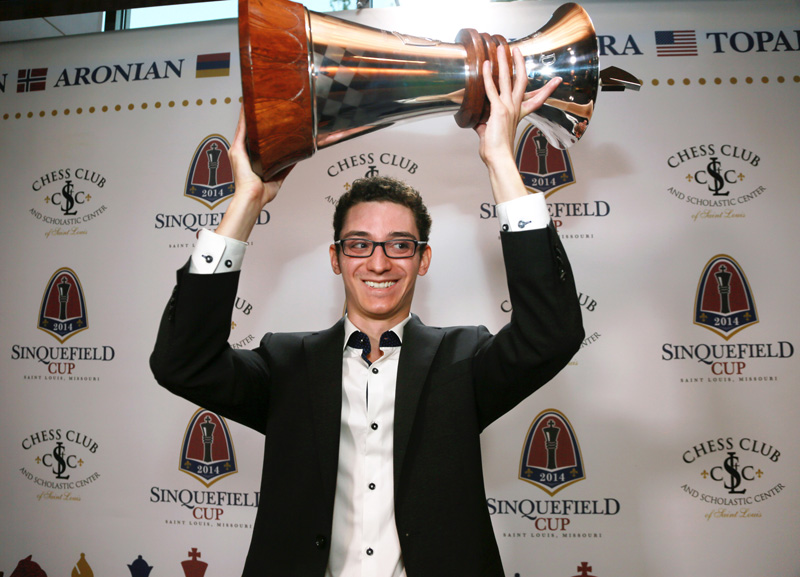
Harry Benson
Fabiano Caruana Holding the Sinquefield Cup Trophy at the Awards Ceremony at the Chess Club and Scholastic Center of Saint Louis
September 7, 2014
24 x 30 in.
Photograph
Collection of the World Chess Hall of Fame
© Harry Benson
Grandmaster Fabiano Caruana triumphantly lifts the Sinquefield Cup trophy above his head in this photograph taken following his victory in the 2014 Sinquefield Cup. That year, the Saint Louis Chess Campus invited renowned photojournalist Harry Benson CBE to document the tournament. Benson photographed for LIFE magazine from 1970 until it closed in 2000, among many other publications. He befriended renowned American chess player Bobby Fischer while covering the 1971 Candidates’ Match, and subsequently created iconic images of the future World Chess Champion as he prepared for the competition and competed against reigning World Chess Champion Boris Spassky.
Harry Benson
Fabiano Caruana Tenant le trophée de la Coupe Sinquefield lors de la cérémonie de remise des prix au Chess Club et au Scholastic Center de Saint Louis
7 septembre 2014
24 x 30 in. (60,96 cm x 76.2 cm)
Photographie
Collection de la World Chess Hall of Fame
© Harry Benson
Le grand maître Fabiano Caruana élève fièrement le trophée de la Coupe Sinquefield au-dessus de sa tête dans cette photo prise après sa victoire lors de la Coupe Sinquefield 2014. Cette année-là, le campus de Saint Louis Chess a invité le photo-journaliste renommé Harry Benson CBE à documenter le tournoi. Benson a photographié le magazine LIFE depuis 1970 jusqu'à sa fermeture en 2000, parmi beaucoup d'autres publications. Il s’est lié d'amitié avec Bobby Fischer, l'ancien joueur américain d'échecs Bobby Fischer en couvrant le Match des candidats de 1971 et a ensuite créé les photographies emblématiques du futur champion mondial d’échecs alors qu'il se préparait à la compétition et qui concourrait à l’époque contre le Champion mondial d'échecs Boris Spassky.
Harry Benson
Fabiano Caruana houdt de Sinquefield Cup Trophy omhoog bij de prijsuitreiking in de Chess Club and Scholastic Center of Saint Louis
7 september 2014
24 x 30 inch
Foto
Collectie van de World Chess Hall of Fame
© Harry Benson
Grootmeester Fabiano Caruana brengt triomfantelijk de Sinquefield Cup trofee boven zijn hoofd in deze foto die is genomen na zijn overwinning van de Sinquefield Cup 2014. In dat jaar nodigde de Saint Louis Chess Campus de beroemde fotojournalist Harry Benson CBE uit om het toernooi te documenteren. Benson fotografeerde voor LIFE magazine van 1970 tot het magazine stopte in 2000, en werkte daarnaast voor veel andere publicaties. Hij raakte bevriend met de beroemde Amerikaanse schaker Bobby Fischer toen hij de Kandidatenmatch won in 1971. Benson maakte vervolgens iconische foto's van de toekomstige wereldkampioen tijdens diens voorbereiding op de match en tijdens de tweekamp tegen de toenmalige wereldschaakkampioen Boris Spassky.
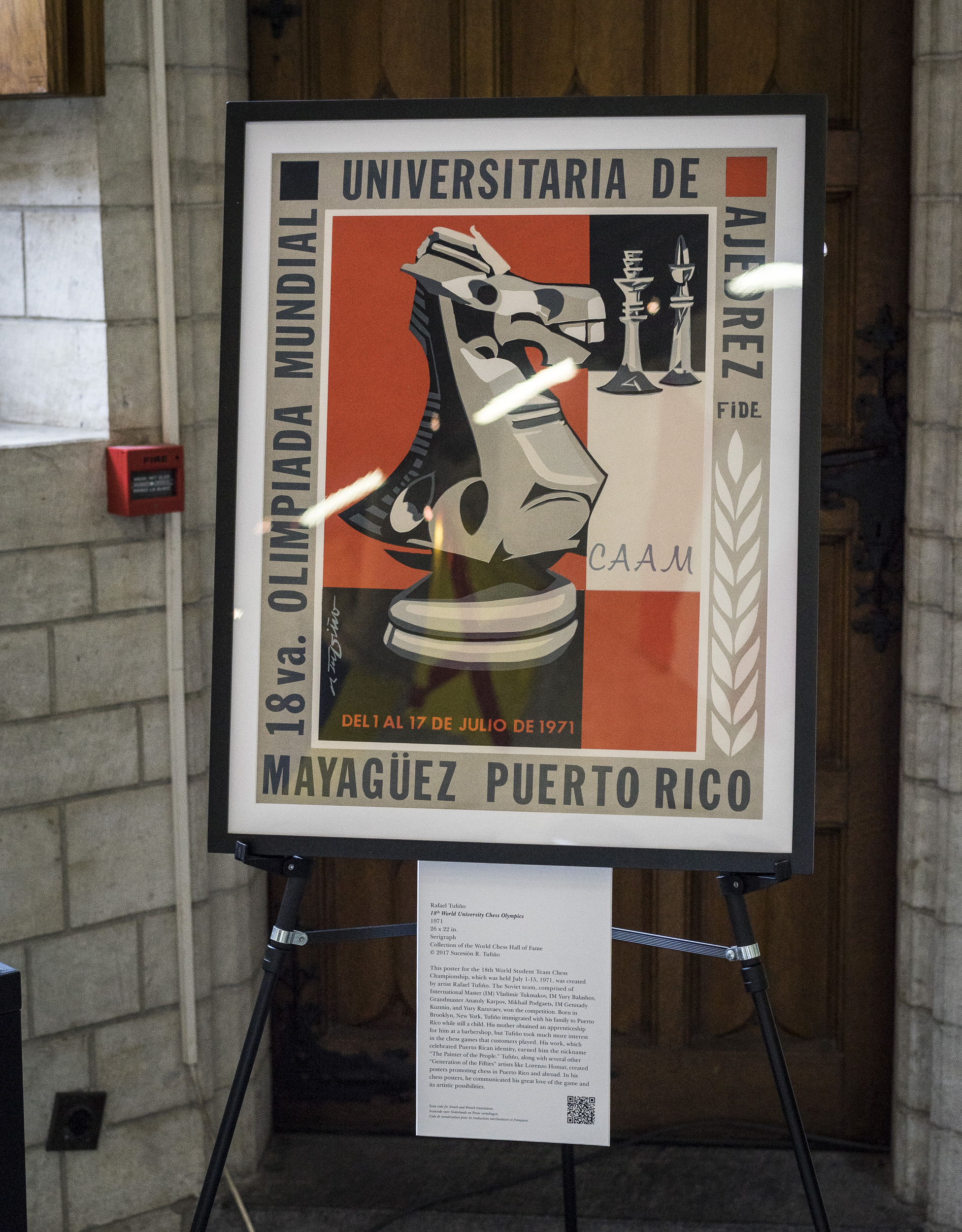
Rafael Tufiño
18th World University Chess Olympics
1971
26 x 22 in.
Serigraph
Collection of the World Chess Hall of Fame
© 2017 Sucesión R. Tufiño
This poster for the 18th World Student Team Chess Championship, which was held July 1-15, 1971, was created by artist Rafael Tufiño. The Soviet team, comprised of International Master (IM) Vladimir Tukmakov, IM Yury Balashov, Grandmaster Anatoly Karpov, Mikhail Podgaets, IM Gennady Kuzmin, and Yury Razuvaev, won the competition. Born in Brooklyn, New York, Tufiño immigrated with his family to Puerto Rico while still a child. His mother obtained an apprenticeship for him at a barbershop, but Tufiño took much more interest in the chess games that customers played. His work, which celebrated Puerto Rican identity, earned him the nickname “The Painter of the People.” Tufiño, along with several other “Generation of the Fifties” artists like Lorenzo Homar, created posters promoting chess in Puerto Rico and abroad. In his chess posters, he communicated his great love of the game and its artistic possibilities.
Rafael Tufiño
18èmes Jeux olympiques de l'université Olympique d’échecs
1971
26 x 22 in. (66 cm x 56 cm)
Sérigraphie
Collection de la World Chess Hall of Fame
© 2017 Succession R. Tufiño
Cette affiche pour le 18ème Championnat du monde d'Équipe d'Étudiants, qui a eu lieu du 1er au 15 juillet 1971, a été créée par l'artiste Rafael Tufiño. L'équipe soviétique, composée du Maître international Vladimir Tukmakov, IM Yury Balashov, le Grand Maître Anatoly Karpov, Mikhail Podgaets, IM Gennady Kuzmin et Yury Razuvaev, ont remporté la compétition. Né à Brooklyn, New York, Tufiño a immigré avec sa famille à Porto Rico alors qu'il était encore enfant. Sa mère a obtenu un apprentissage pour lui dans une salon de coiffure, mais Tufiño s'intéresse beaucoup plus aux jeux d'échecs qu’aux clients du salon. Son travail, qui met en avant l'identité portoricaine, lui a valu le surnom de « peintre du peuple ». Tufiño, ainsi que plusieurs autres artistes de la génération des années cinquante comme Lorenzo Homar, ont créé des affiches pour promouvoir les échecs à Porto Rico et à l'étranger. Dans ses affiches d'échecs, il a communiqué son grand amour du jeu et ses possibilités artistiques.
Rafael Tufiño
18de Wereldschaakolympiade voor Universiteiten
1971
26 x 22 inch
Zeefdruk
Collectie van de World Chess Hall of Fame
© 2017 Sucesión R. Tufiño
Deze poster voor het 18de Wereldstudentenkampioenschap schaken, dat werd gehouden van 1-15 juli 1971, is gemaakt door kunstenaar Rafael Tufiño. Het Sovjet-team, bestaande uit Internationaal Meester (IM) Vladimir Tukmakov, IM Yury Balashov, grootmeester Anatoly Karpov, Mikhail Podgaets, IM Gennady Kuzmin en Yury Razuvaev, won het toernooi. Tufiño werd geboren in Brooklyn, New York, maar emigreerde met zijn familie naar Puerto Rico toen hij nog een kind was. Zijn moeder verzorgde een stageplaats voor hem in een kapperszaak, maar Tufiño toonde veel meer interesse in de schaakpartijen die zijn klanten speelden. Zijn werk, die de Puerto Ricoanse identiteit bezielde, verdiende hem de bijnaam "De schilder van het volk." Tufiño, samen met diverse andere 'Generation of the Fifties' artiesten zoals Lorenzo Homar, creëerde posters die schaken promootte in Puerto Rico en in het buitenland. In zijn schaakplakkaten brengt hij zijn grote liefde voor het spel over en toont hij zijn artistieke mogelijkheden.
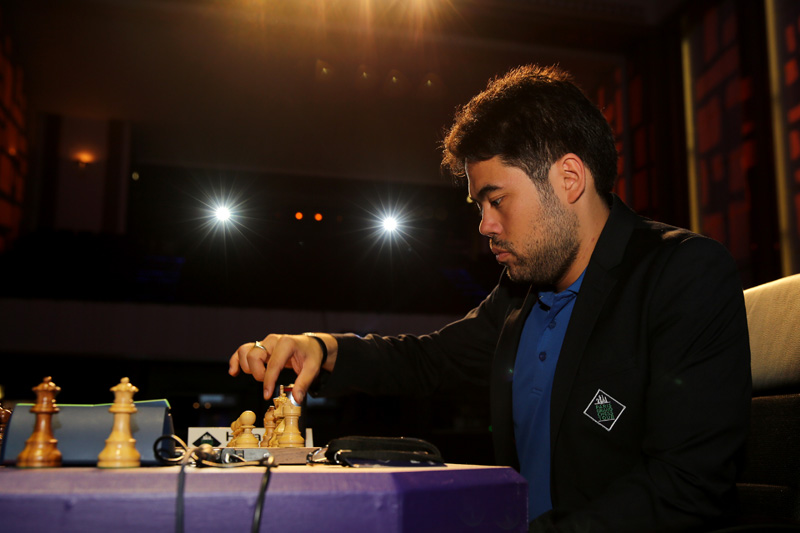
Spectrum Studios
Hikaru Nakamura Competes during Rapid Day Two of the 2016 Paris Grand Chess Tour
June 10, 2016
10 7/8 x 13 7/8 in.
Photograph
Collection of the World Chess Hall of Fame
Spectrum Studios
Hikaru Nakamura Concourt pendant les Rapid Day Two de 2016 à Paris Grand Chess Tour
June 10, 2016
10 7/8 x 13 7/8 in. (27,75 cm x 35,25 cm)
Photographie
Collection du World Chess Hall of Fame
Spectrum Studios
Hikaru Nakamura tijdens de tweede dag rapidschaak van de Grand Chess Tour 2016 in Parijs
10 juni 2016
10 7/8 x 13 7/8 inch
Foto
Collectie van de World Chess Hall of Fame
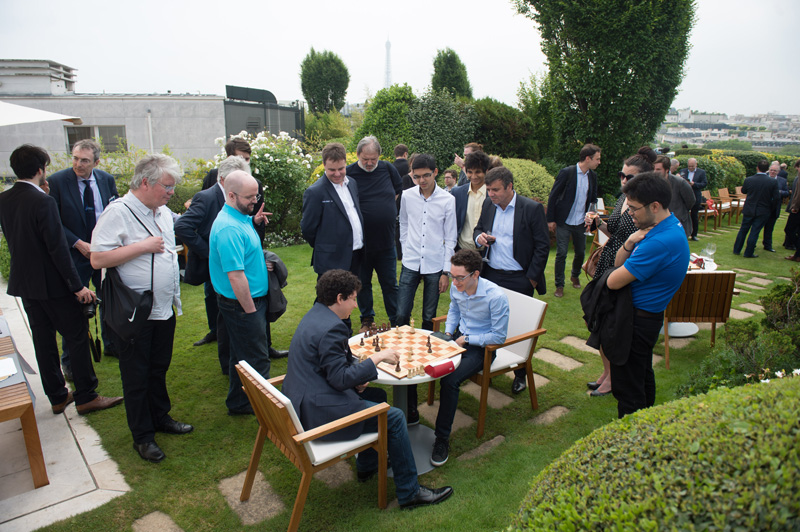
Spectrum Studios
Alejandro Ramirez and Fabiano Caruana Compete during the Pre-Round Activities of the 2016 Paris Grand Chess Tour
June 8, 2016
10 7/8 x 13 7/8 in.
Photograph
Collection of the World Chess Hall of Fame
Spectrum Studios
Alejandro Ramirez et Fabiano Caruana pendant les Activitées des pré-selection du Grand Tournoi d’échec à Paris en 2016
June 8, 2016
10 7/8 x 13 7/8 in. (27,75 cm x 35,25 cm)
Photographie
Collection de la World Chess Hall of Fame
Spectrum Studios
Alejandro Ramirez en Fabiano Caruana spelen tijdens de openingsactiviteiten van de Grand Chess Tour 2016 in Parijs
8 juni 2016
10 7/8 x 13 7/8 inch
Foto
Collectie van de World Chess Hall of Fame
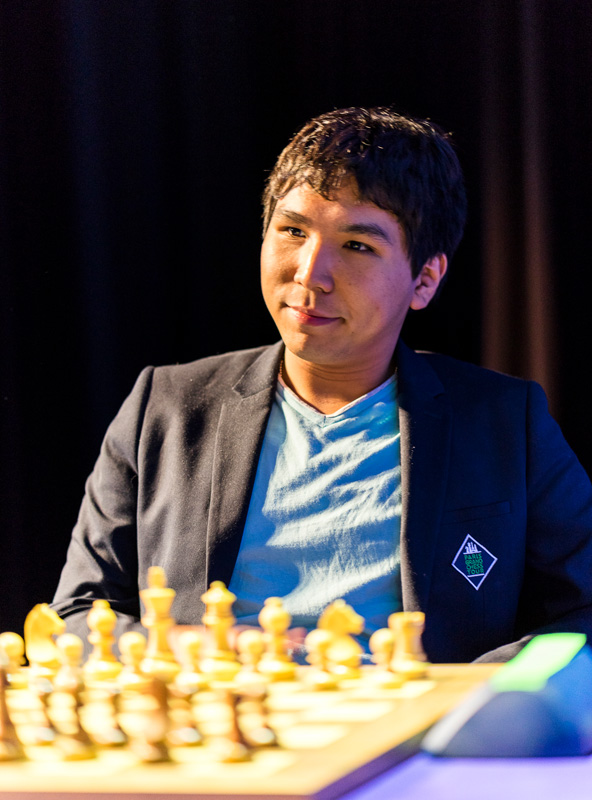
Lennart Ootes
Wesley So Competes during Rapid Day One of the 2016 Paris Grand Chess Tour
June 9, 2016
13 7/8 x 10 7/8 in.
Photograph
Collection of the World Chess Hall of Fame
Courtesy of Paris Grand Chess Tour
Lennart Ootes
Wesley So Concourant pendant le premier jour du Grand Tournoi d’échec à Paris
June 9, 2016
13 7/8 x 10 7/8 in. (27,75 cm x 35,25 cm)
Photographie
Collection de la World Chess Hall of Fame
Courtesy of Paris Grand Chess Tour
Lennart Ootes
Wesley So speelt tijdens de eerste dag rapidschaak in de Grand Chess Tour 2016 in Parijs
9 juni 2016
13 7/8 x 10 7/8 inch
Foto
Collectie van de World Chess Hall of Fame
Hoffelijkheid van de Grand Chess Tour Parijs
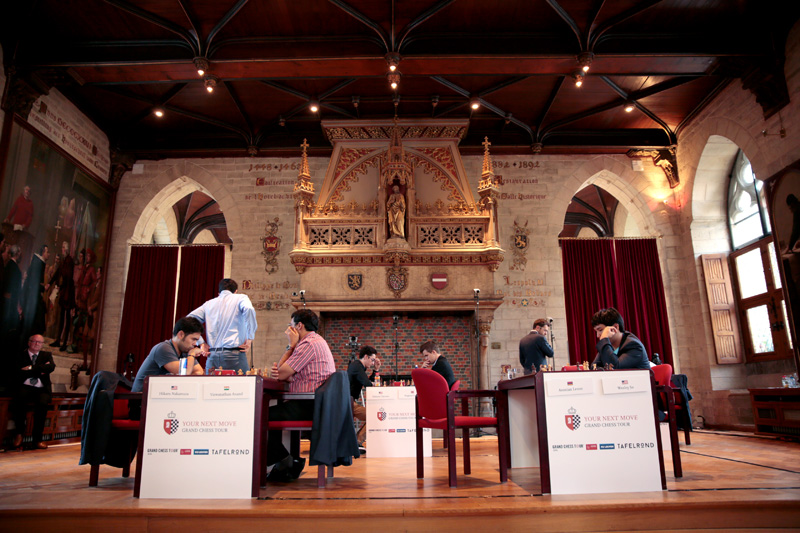
Spectrum Studios
Competitors during Rapid Day One of the 2016 Your Next Move Grand Chess Tour
June 17, 2016
10 7/8 x 13 7/8 in.
Photograph
Collection of the World Chess Hall of Fame
The Grand Chess Tour (GCT) is a circuit of international chess competitions that features the world’s best chess players. The first Grand Chess Tour took place in 2015 and included three tournaments: Norway Chess (Stavanger), the Sinquefield Cup (Saint Louis, Missouri), and the London Chess Classic. World Chess Champion Magnus Carlsen won the first installment.
The second GCT occurred in 2016 and was won by American Grandmaster Wesley So. While the circuit still included the Sinquefield Cup and London Chess Classic, it also included two new events: Paris Grand Chess Tour and Your Next Move Grand Chess Tour (Leuven, Belgium)). The selection of photographs on view here were taken at the 2016 Pairs Grand Chess Tour and Your Next Move Grand Chess Tour events. The World Chess Hall of Fame collects photographs and artifacts from each of these tournaments, preserving them for future generations of chess lovers.
Spectrum Studios
Concurrents pendant le Rapid Day One de 2016 Your Next Move Grand Chess Tour
June 17, 2016
10 7/8 x 13 7/8 in. (27,75 cm x 35,25 cm)
Photographie
Collection de la World Chess Hall of Fame
Le Grand Chess Tour (GCT) est un circuit de compétitions internationales d'échecs qui présente les meilleurs joueurs d'échecs au monde. Le premier Grand Chess Tour a eu lieu en 2015 et a inclus trois tournois: Norway Chess (Stavanger), la Sinquefield Cup (Saint Louis, Missouri) et le London Chess Classic. Champion du monde d'échecs Magnus Carlsen a remporté la première partie.
Le deuxième GCT a eu lieu en 2016 et a été gagné par le Grandmaster américain Wesley So. Alors que le circuit comprenait toujours la Sinquefield cup et London Chess Classic, il comprenait également deux nouveaux événements : Paris Grand Chess Tour et Your Next Move Grand Chess Tour (Louvain, Belgique)). La sélection des photographies en vue ici a été prise lors des événements de l'automne 2006 du Grand Chess et de Your Next Move Grand Chess Tour. La World Chess Hall of Fame recueille des photographies et des pièces de chacun de ces tournois, les préservant pour les générations futures d'amateurs d'échecs.
Spectrum Studios
De spelers tijdens de eerste dag rapidschaak van de Your Next Move Grand Chess Tour 2016
17 juni 2016
10 7/8 x 13 7/8 inch
Foto
Collectie van de World Chess Hall of Fame
De Grand Chess Tour (GCT) is een serie van internationale schaakcompetities met de beste schaakspelers ter wereld. De eerste Grand Chess Tour vond plaats in 2015 en omvatte drie toernooien: Norway Chess (Stavanger), de Sinquefield Cup (Saint Louis, Missouri) en de London Chess Classic. Wereldschaakkampioen Magnus Carlsen won de eerste editie.
De tweede GCT vond plaats in 2016 en werd gewonnen door de Amerikaanse Grootmeester Wesley So. Terwijl de tour nog steeds de Sinquefield Cup en London Chess Classic omvatte, werden er ook twee nieuwe evenementen toegevoegd: Parijs Grand Chess Tour en Your Next Move Grand Chess Tour (Leuven, België). De selectie foto's die hier worden getoond, zijn genomen tijdens de Paris Grand Chess Tour en Your Next Move Grand Chess Tour evenementen in 2016. De World Chess Hall of Fame verzamelt foto's en artefacten van elk van deze toernooien en behoudt ze voor toekomstige generaties schaakliefhebbers.
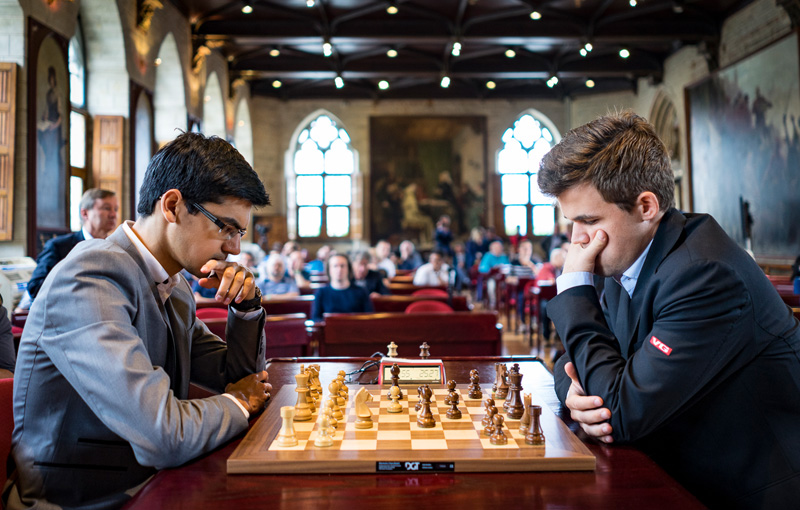
Lennart Ootes
Anish Giri and Magnus Carlsen Compete During Rapid Day Two of the 2016 Your Next Move Grand Chess Tour
June 18, 2016
13 7/8 x 10 7/8 in.
Photograph
Collection of the World Chess Hall of Fame
Lennart Ootes
Anish Giri et Magnus Carlsen Concourant pendant Rapid jour 2 de 2016 de Your Next Move Grand Chess Tour
June 18, 2016
13 7/8 x 10 7/8 in. (27,75 cm x 35,25 cm)
Photographie
Collection de la World Chess Hall of Fame
Lennart Ootes
Anish Giri en Magnus Carlsen spelen tijdens dag twee van het rapidschaak van de Your Next Move Grand Chess Tour 2016
18 juni 2016
13 7/8 x 10 7/8 inch
Foto
Collectie van de World Chess Hall of Fame
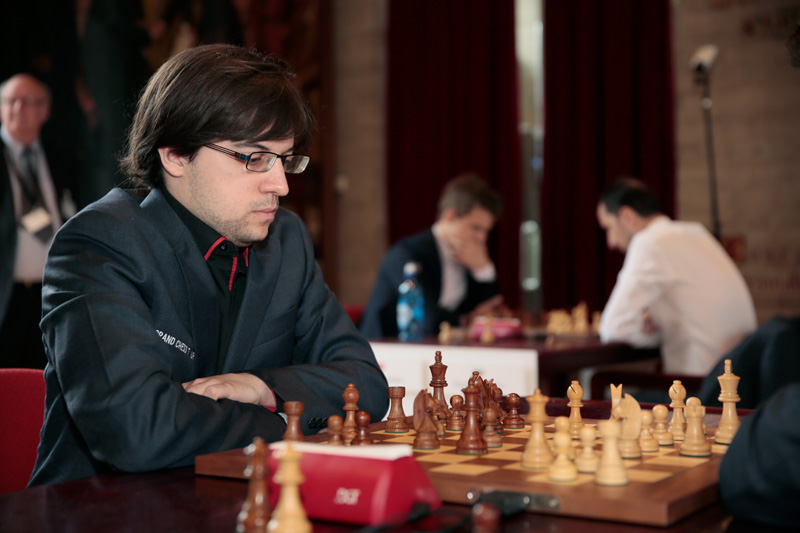
Hugo Maris
Maxime Vachier-Lagrave Competes during Blitz Day One of the 2016 Your Next Move Grand Chess Tour
June 19, 2016
10 7/8 x 13 7/8 in.
Photograph
Collection of the World Chess Hall of Fame
Courtesy of Your Next Move Grand Chess Tour
Hugo Maris
Maxime Vachier-Lagrave Concourant pendant la Blitz jour 1 de 2016 de Your Next Move Grand Chess Tour
June 19, 2016
10 7/8 x 13 7/8 in. (27,75 cm x 35,25 cm)
Photographie
Collection de la World Chess Hall of Fame
Autorisation de Your Next Move Grand Chess Tour
Hugo Maris
Maxime Vachier-Lagrave speelt tijdens de eerste dag snelschaken van de Your Next Move Grand Chess Tour 2016
19 juni 2016
10 7/8 x 13 7/8 inch
Foto
Collectie van de World Chess Hall of Fame
Hoffelijkheid van Your Next Move Grand Chess Tour
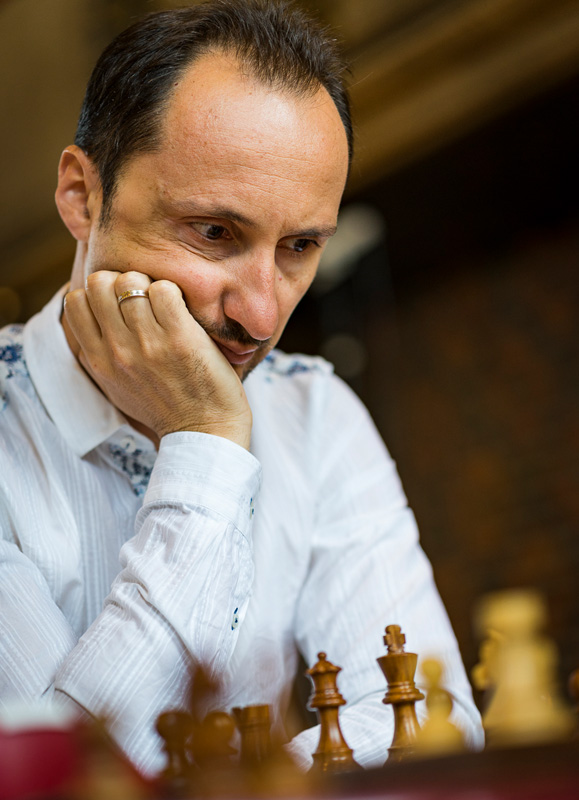
Lennart Ootes
Veselin Topalov Competes during Blitz Day Two of the 2016 Your Next Move Grand Chess Tour
June 20, 2016
13 7/8 x 10 7/8 in.
Photograph
Collection of the World Chess Hall of Fame
Lennart Ootes
Veselin Topalov concourant pendant la Blitz jour 2 de 2016 de Your Next Move Grand Chess Tour
June 20, 2016
13 7/8 x 10 7/8 in. (27,75 cm x 35,25 cm)
Photographie
Collection de la World Chess Hall of Fame
Lennart Ootes
Veselin Topalov speelt tijdens de tweede dag snelschaken van de Your Next Move Grand Chess Tour 2016
20 juni 2016
13 7/8 x 10 7/8 inch
Foto
Collectie van de World Chess Hall of Fame
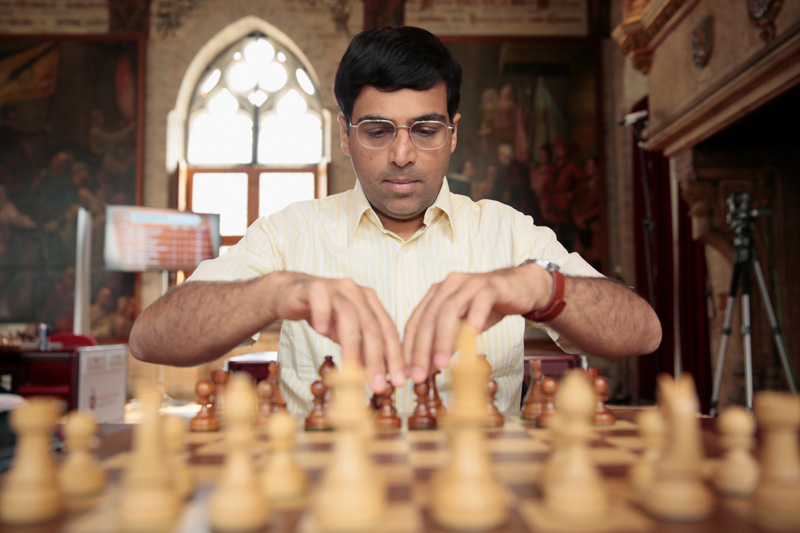
Spectrum Studios
Viswanathan Anand Competes during Rapid Day Two of the 2016 Your Next Move Grand Chess Tour
June 18, 2016
10 7/8 x 13 7/8 in.
Photograph
Collection of the World Chess Hall of Fame
Spectrum Studios
Viswanathan Anand concourt pendant le deuxième jour de 2016 18 juin 2016
10 7/8 x 13 7/8 in.
Your Next Move Grand Chess Tour
Photographie
Collection du de la la World Chess Hall of Fame
Spectrum Studios
Viswanathan Anand speelt tijdens de tweede dag rapidschaak van de Your Next Move Grand Chess Tour 2016
18 juni 2016
10 7/8 x 13 7/8 inch
Foto
Collectie van de World Chess Hall of Fame
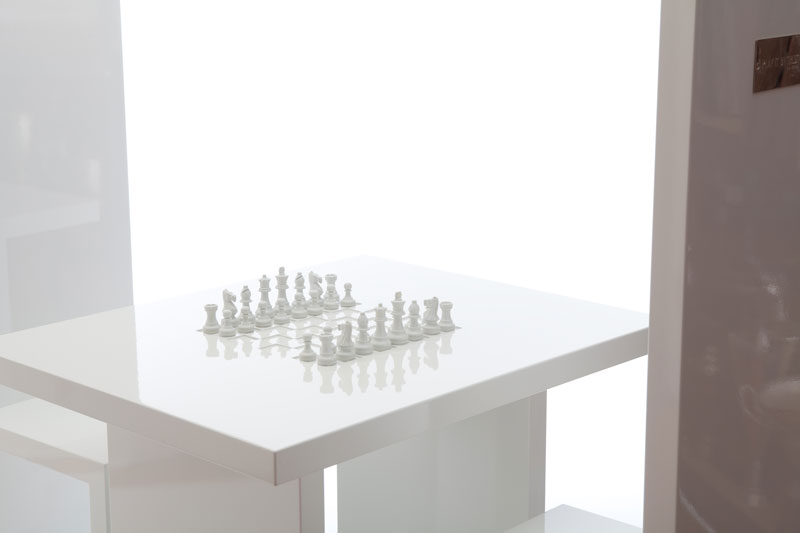
Yoko Ono
Play It by Trust (Roskilde Version)
2002
Edition 3 of 6
King size: 3 ¼ in. Chairs: 54 x 16 x 18 in. Table: 29 x 36 x 30 in.
Wood chairs, table, and chess pieces
Collection of Dr. Jeanne and Rex Sinquefield
Starkly beautiful in its austere appearance and its unflinchingly straightforward concept, artist and longtime peace activist Yoko Ono’s (b. 1933) all-white chess set Play It by Trust marries the spare, geometric lines of Minimalism with the intimate, playful interactivity of the games produced by the members of Fluxus, an international avant-garde movement with which Ono was associated in the 1960s. Originally conceived as the White Chess Set in 1966, Play It by Trust was born of a tumultuous era characterized by the Cold War tensions of the nuclear arms race, the military conflict in Vietnam, and the struggle for civil rights in the United States. As the players are forced into ever-greater reliance on each other to identify which piece belongs to which player as the game progresses, Ono elegantly re-contextualizes a game that is normally thought of as a microcosmic allegory of war, emphasizing collaboration over competition and empathy over the opposition.
Yoko Ono
Play It by Trust (Roskilde Version)
2002
Edition 3 de 6
Hauteur du Roi: 3 ¼ in. (7.62 cm)
Chaises : 54 x 16 x 18 in. (137.16 cm x 40.64 cm x 45.72 cm)
Table: 29 x 36 x 30 in. (73.66 cm x 91.44 cm x 76.2 cm)
Chaises de bois, table, et pièces d’échiquier
Collection de Dr. Jeanne et Rex Sinquefield
Remarquablement beau dans son apparence et son concept austère, son artiste et activiste pour la paix Yoko Ono (1933) a su marier dans cet échiquier, que compose Play It by Trust, les lignes géométriques du minimalisme avec l'interactivité et la part ludique du jeu d’échecs. Cette oeuvre a été créée par les membres du Fluxus, un mouvement international avant-gardiste avec lequel Ono s’est associée dans les années 1960. Initialement conçue sous le nom de White Chess Set en 1966, Play It by Trust est né pendant une ère tumultueuse caractérisée par la course à l’armement nucléaire durant les tensions de la guerre froide, le conflit militaire au Vietnam et la lutte pour les droits civiques aux États-Unis. Au fur-et-à-mesure que le jeu progresse, les joueurs sont forcés à s’entraider afin d’identifier quelles sont leurs propres pièces. Par ce système de pièces uniquement blanche, Ono réinvente le jeu des échecs, qui est une allégorie de la guerre en soit, en mettant l'accent sur la collaboration entre les concurrents et l'empathie de ceux-ci.
Yoko Ono
Play It by Trust (Roskilde Version)
2002
Uitgave 3 van de 6
Koningshoogte: 3 ¼ inch Stoelen: 54 x 16 x 18 inch. Tafel: 29 x 36 x 30 inch
Houten stoelen, tafels en schaakstukken
Collectie van Dr. Jeanne en Rex Sinquefield
Krachtig in zijn strakke uitstraling en zijn onvoorstelbaar eenvoudige concept, verenigt kunstenaar en langdurige vredesactivist Yoko Ono's (geboren 1933) witte schaakspel Play It by Trust de opvullende geometrische lijnen van het Minimalisme met de intieme, speelse interactiviteit van de partijen. Het spel is geproduceerd door de leden van Fluxus, een internationale avant-garde-beweging waarmee Ono in de jaren zestig werd geassocieerd. Oorspronkelijk ontworpen als de White Chess Set in 1966, werd Play It by Trust gemaakt tijdens een onstuimig tijdperk gekenmerkt door de spanningen van de Koude Oorlog met haar kernwapenrace, het militaire conflict in Vietnam en de strijd voor burgerrechten in de Verenigde Staten. Naarmate het spel vordert worden de spelers in steeds grotere afhankelijkheid van elkaar gedwongen om te identificeren welk stuk toehoort tot welke speler, plaatst Ono op elegante wijze een spel dat normaal gesproken wordt beschouwd als een microkosmische oorlogsverklaring in een andere context, waarbij samenwerking boven competitie wordt gesteld en en empathie boven oppositie.
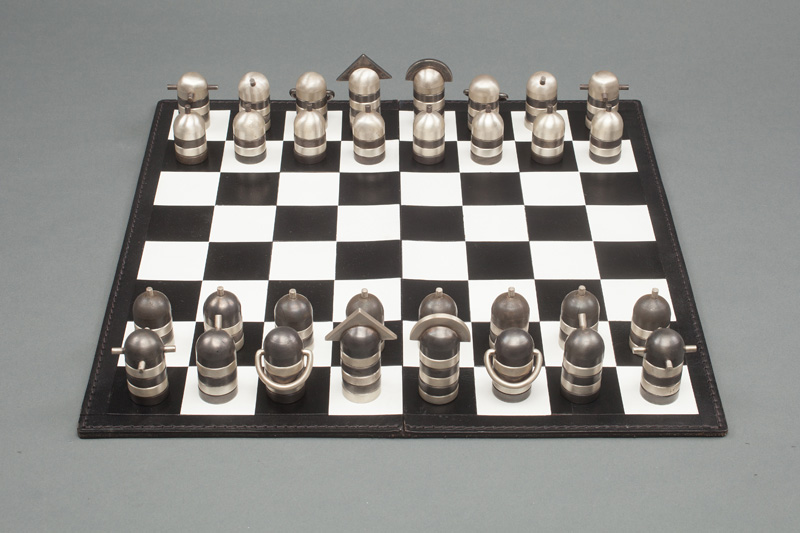
Austria
Emil Pott
Manufactured by Tiffany & Co.
Tiffany & Co. Silver Chess Set and Board
c 1970s
King size: 2 ⅜ in.
Board: 3/16 x 14 ¼ x 14 ¼ in.
Sterling silver, pewter, and leather
Collection of the World Chess Hall of Fame, gift of Bernice and Floyd Sarisohn
This is one of many sets donated to the World Chess Hall of Fame by Floyd Sarisohn, a lawyer from Long Island, New York, and his wife, Bernice, who are both avid collectors of chess sets. This solid pewter and sterling silver set, designed by Emil Pott, was made in Austria for Tiffany & Co. in the 1970s. Together with the board, which is inlaid with black and white leather, this is a classic example of the use of abstraction in modern chess set design.
Autriche
Emil Pott
Fabriqué par Tiffany & Co.
Tiffany & Co. Ensemble et plateau d'échecs en argent
Taille maximum: 2 ⅜ in. (5.08 cm)
Plateau: 3/16 x 14 ¼ x 14 ¼ in. (7.62 cm x 35.56 cm x 35.56 cm)
Argent fin, étain et cuir
Collection de la World Chess Hall of Fame, don de Bernice et Floyd Sarisohn
C'est un des nombreux ensembles donnés à la World Chess Hall of Fame par Floyd Sarisohn, un avocat de Long Island, à New York, et son épouse, Bernice, qui sont tous deux des collectionneurs passionnés d'échecs. Cet ensemble solide d'étain et d'argent fin, conçu par Emil Pott, a été fabriqué en Autriche pour Tiffany & Co. dans les années 1970. Avec son plateau de jeu incrusté de cuir noir et blanc, cet ensemble est l’exemple parfait d’un style épuré et minimaliste propre au design des jeux d’échecs modernes.
Oostenrijk
Emil Pott
Geproduceerd door Tiffany & Co.
Tiffany & Co. Zilveren Schaakset en Bord
In de jaren zeventig
Koningshoogte: 2 ⅜ inch
Bord: 3/16 x 14 ¼ x 14 ¼ inch
Sterlingzilver, tin en leer
Collectie van de World Chess Hall of Fame, geschenk van Bernice en Floyd Sarisohn
Dit is een van de vele sets die door schaakspelverzamelaars Floyd Sarisohn, een advocaat uit Long Island, New York, en zijn vrouw, Bernice, zijn geschonken aan de World Chess Hall of Fame. Deze set van peauter en sterlingzilveren, ontworpen door Emil Pott, werd in de jaren '70 in Oostenrijk gemaakt voor Tiffany & Co. Samen met het bord, dat is ingelegd met zwart en wit leer, is dit een klassiek voorbeeld van het gebruik van abstractie in het moderne schaakspelontwerp.
Plastoy
Asterix and Caesar’s Gift
2006
King sizes: Caesar: 4 1∕8 in., Asterix: 3 ¼ in.
Board: 16 ¾ x 16 ¾ in.
Plastic pieces, cardboard board
Collection of Bernice and Floyd Sarisohn
White: Romans
- King: Julius Caesar
- Queen: Cleopatra
- Bishop: Nefarius Purpus
- Bishop: Motus
- Knight: Imperial Lions
- Rook: Corinthian Columns
- Pawn: Roman Eagle
Brown: Gauls
- King: Vitalstatistix
- Queen: Impedimenta
- Bishop: Asterix
- Bishop: Obelix
- Knight: Wild Boar
- Rook: Menhir
- Pawn: Chanticleerix
This chess set features Asterix, one of the most famous cartoon characters in Europe. The popularity of the comics linked to this character has inspired the books to be translated into over 29 languages and converted into multiple movies. Writer Rene Goscinny and cartoon artist Albert Uderzo were the producers of the series. The series is about Asterix, a short but shrewd Gaul, who, with the help of a magic potion and his friend Obelix, can defeat an entire Roman patrol. The story is set in Gaul, a historic area in western France, in the era when it was one of the few regions free of Roman rule. The story revolves around Asterix and Obelix’s adventures as they continue to fight and best the Roman Empire.
Jouet en plastique
Astérix et le cadeau de César
2006
Taille du roi : César : 4 1∕8 in. (10,16 cm), Astérix : 3 ¼ in. (7,62 cm)
Plateau : 16 ¾ x 16 ¾ in. (40,64 cm x 40,64 cm)
Pièces en plastique, plateau en carton
Collection de Bernice and Floyd Sarisohn
Pièces blanches : Les romains
- Pièces blanches : Les romains
- Roi : Jules César
- Reine : Cléopâtre
- Fou : Hotelterminus
- Fou : Motus
- Cavaliers : Lions impériaux
- Tours : Colonnes corinthians
- Pions : Aigle Romain
Pièces Noires : Les Gaulois
- Roi : Abraracourcix
- Reine : Bonemine
- Fou : Astérix
- Fou : Obélix
- Cavaliers : Sangliers sauvages
- Tours : Menhir
- Pions : Chanteclairix
Cet échiquier reprend l’univers d’une des plus célèbre série de bandes-dessinées en Europe : Astérix. La renommée de ce personnage, éponyme à l’oeuvre originale, est telle qu’elle s’est traduite dans plus de 29 langues et a été adaptée plusieurs fois en film. L'écrivain René Goscinny et l'artiste dessinateur Albert Uderzo étaient les producteurs de la série. La série traite d’un petit mais ingénieux Gaulois nommé Astérix et de son ami Obélix, qui peuvent à l’aide de la potion magique vaincre une tout une patrouille Romaine. L'histoire se déroule dans la Gaule, dans une région historique de l'ouest de la France, à l'époque où elle était l'une des rares régions sans domination romaine. La série de bandes-dessinées narre les aventures d'Astérix et d'Obélix qui résistent toujours et encore à l'Empire romain.
Plastoy
Asterix and Caesar's Gift
2006
Koningshoogte: Caesar: 4 1/8 inch., Asterix: 3 ¼ inch
Bord: 16 ¾ x 16 ¾ inch
Plastic stukken, kartonnen karton
Collectie van Bernice en Floyd Sarisohn
Wit: Romeinen
- Koning: Julius Caesar
- Dame: Cleopatra
- Loper: Nefarius Purpus
- Loper: Motus
- Paard: Keizerlijke Leeuwen
- Toren: Corinthische Kolommen
- Pion: Romeinse Adelaar
Bruin: Galliërs
- Koning: Vitalstatistix
- Dame: Impedimenta
- Loper: Asterix
- Loper: Obelix
- Paard: Wilde Zwijn
- Toren: Menhir
- Pion: Chanticleerix
Dit schaakspel staat in het teken van Asterix, een van de beroemdste cartoonkarakters in Europa. Vanwege de populariteit van de stripverhalen over dit karakter zijn de stripboeken vertaald in meer dan 29 talen en heeft het als basis gestaan voor meerdere films. Schrijver Rene Goscinny en cartoonkunstenaar Albert Uderzo waren de producenten van de serie. De serie gaat over Asterix, een korte maar sluwe Galliër, die met behulp van een magisch drankje en zijn vriend Obelix, een voltallige Romeinse patrouille kan verslaan. Het verhaal speelt zich af in Gallië, een historisch rijk gebied in West-Frankrijk, in het tijdperk waarin het als een van de weinige regio's niet werd bezet door de Romeinen. Het verhaal draait om de avonturen van Asterix en Obelix, waarin zij het Romeinse Rijk blijven bestrijden en verslaan.
Knut Naerum, Magnus Carlsen, Gorm Transgaard, Paul Halas, Olaf Solstrand, Gaute Moe, Bill Walsh, Jens Hansegård, and Jan Kruse (writers); Siv Østeng Hansen, Arild Midthun, Fabian, Miguel, Fabrizio Petrossi, Daniel Perez, Manuel Gonzales, Miguel Pujol, and Sander Gulien (pencilers); Arild Midthun, Fabian, Miguel, Fabrizio Petrossi, Daniel Perez, Manuel Gonzales, Miguel Pujol, and Sander Gulien (inkers); Unknown (colorist and letterer)
Donald Duck & Co No. 45
November 2014
Walt Disney
Collection of the World Chess Hall of Fame
Donald Duck and reigning World Chess Champion Magnus Carlsen shared the cover of this issue of the Norwegian comic book Donald Duck. Carlsen, an avid fan of the comic, helped develop the special edition book, which discussed chess history and how to play the game. The book came with a magnetic pocket chess set for readers.
Knut Naerum, Magnus Carlsen, Gorm Transgaard, Paul Halas, Olaf Solstrand, Gaute Moe, Bill Walsh, Jens Hansegård, et Jan Kruse (auteurs); Siv Østeng Hansen, Arild Midthun, Fabian, Miguel, Fabrizio Petrossi, Daniel Perez, Manuel Gonzales, Miguel Pujol, and Sander Gulien (dessins); Arild Midthun, Fabian, Miguel, Fabrizio Petrossi, Daniel Perez, Manuel Gonzales, Miguel Pujol, and Sander Gulien (encres); Unknown (Couleurs et lettres)
Donald Duck & Co No. 45
Novembre 2014
Walt Disney
Collection de la World Chess Hall of Fame
Donald Duck et le champion mondial en échec Magnus Carlsen ont partagés la couverture de ce numéro du recueil de bandes dessinés Norvégien Donald Duck. Carlsen, un fervent fan de la bande dessinée éponyme, a contribué à développer l’édition spécial du livre, qui décrit l'histoire des échecs et expose les règles de ce jeu de réflexion. Le livre est livré avec un jeu d'échecs de poche aimantée pour les lecteurs.
Knut Naerum, Magnus Carlsen, Gorm Transgaard, Paul Halas, Olaf Solstrand, Gaute Moe, Bill Walsh, Jens Hansegård en Jan Kruse (schrijvers); Siv Østeng Hansen, Arild Midthun, Fabian, Miguel, Fabrizio Petrossi, Daniel Perez, Manuel Gonzales, Miguel Pujol en Sander Gulien (tekenaars); Arild Midthun, Fabian, Miguel, Fabrizio Petrossi, Daniel Perez, Manuel Gonzales, Miguel Pujol en Sander Gulien (inkters); Onbekend (kleuren en letters)
Donald Duck & Co No. 45
November 2014
Walt Disney
Collectie van de World Chess Hall of Fame
Donald Duck en de regerend wereldschaakkampioen Magnus Carlsen staan samen op de cover van dit nummer van het Noorse stripboek Donald Duck. Carlsen, een groot fan van het stripverhaal, werkte mee bij het ontwikkelen van deze speciale editie, waarin de schaakgeschiedenis en de regels van het spel worden behandeld. Het boek kwam met een magnetische zakschaakspel voor de lezers.
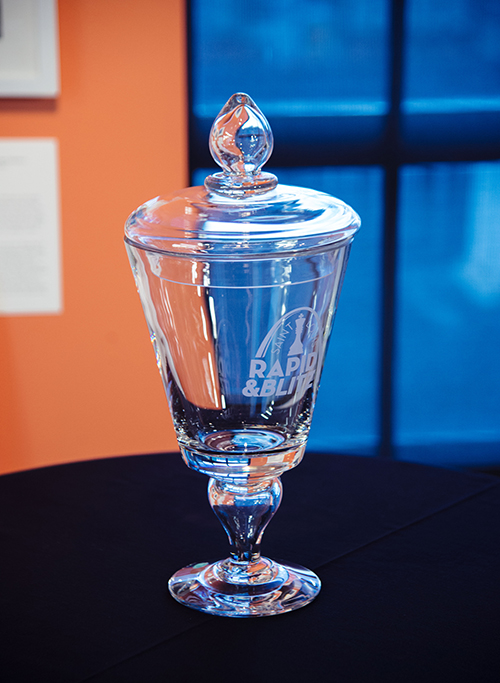
Tiffany & Co.
Grand Chess Tour Saint Louis Rapid & Blitz Trophy
2017
16x71∕4 in.
Crystal
Collection of the Chess Club and Scholastic Center of Saint Louis, gift of Tiffany & Co.
Tiffany & Co. generously provided this trophy, the 14-inch Britannia Cup Award, for the rst installment of the Saint Louis Rapid & Blitz tournament. The competition is part of the Grand Chess Tour, a global circuit of chess competitions that also includes the Sinque eld Cup. The Saint Louis Rapid & Blitz tournament was held August 13- 19, 2017, and was won by Grandmaster Levon Aronian. World Chess Champion Garry Kasparov also competed, returning to tournament play after his 2005 retirement.
Tiffany & Co.
Grand Chess Tour Saint Louis Rapid & Blitz Trofee
2017
16 x 7 1 ∕4 in.
Kristal
Collectie van de Chess Club and Scholastic Center in Saint Louis, Geschenk van Tiffany & Co.
Tiffany & Co. heeft deze 14-inch Britannia Cup Trofee genereus ter beschikking gesteld voor de eerste editie van het Saint Louis Rapid & Blitz schaaktoernooi. Het evenement is onderdeel van de Grand Chess Tour, een wereldwijd circuit van schaaktoernooien dat ook de Sinquefield Cup omvat. Het Saint Louis Rapid & Blitz toernooi werd gehouden van 13 t/m 19 Augustus 2017 en werd gewonnen door grootmeester Levon Aronian. Voormalig wereldkampioen Garry Kasparov deed ook mee aan het toernooi en vierde daarmee zijn terugkeer nadat hij zich in 2005 zich terugtrok uit het professioneel schaak.
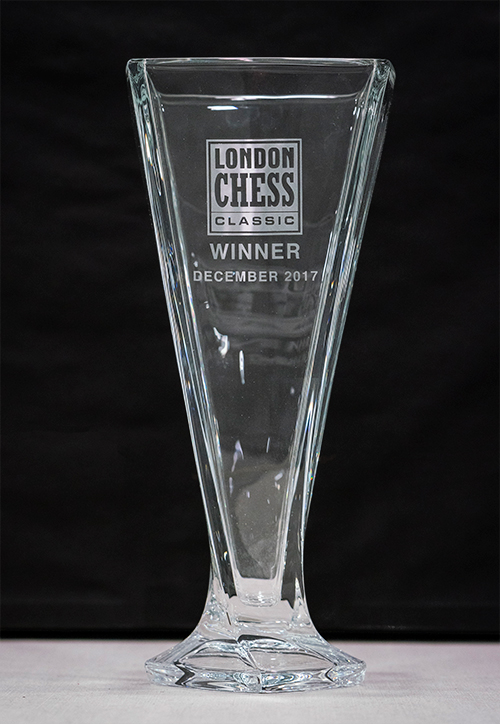
Create Services and Burridge
London Chess Classic Trophy
2017
13 in.
Crystal
Collection of the London Chess Classic
Established in 2009, the London Chess Classic is an elite chess tournament organized annually by Chess in Schools and Communities, an organization that seeks “to improve children’s educational outcomes and social development by introducing them to the game of chess.” In 2015, the tournament became part of the Grand Chess Tour, a global circuit of competitions featuring the top players in the world. The trophy features the London Chess Classic’s logo, the style of which is partially inspired by that of boxing events. Create Services has commissioned Burridge, a traditional family company with a track record of producing hand-engraved trophies for prestigious golf tournaments.
Create Services and Burridge
Trophée du London Chess Classic
2017
33 cm
En Cristal
Collection du London Chess Classic
Établi en 2009, le London Chess Classic est un tournoi élite d'échecs organisé chaque année par Chess in Schools and Communities, une organisation qui cherche à «améliorer les résultats scolaires et le développement social des enfants grâce à l'introduction des échecs». En 2015, le tournoi est devenu une partie du Grand Chess Tour, un circuit mondial de compétitions mettant en vedette les meilleurs joueurs du monde. Le trophée porte le logo du London Chess Classic, inspiré en partie par le style de ceux à des épreuves de boxe. Create Services a mandaté Burridge, une entreprise familiale avec une riche tradition de production de trophées gravés à la main pour des tournois de golf prestigieux.
Create Services and Burridge
London Chess Classic Trofee
2017
13 in.
Kristal
Collectie van de London Chess Classic
De London Chess Classic, opgericht in 2009, is een elite schaaktoernooi dat jaarlijks wordt georganiseerd door Chess in Schools and Communities, een organisatie die streeft naar "verbetering van de educatieve resultaten en sociale ontwikkeling van kinderen door hen voor te introduceren aan het schaakspel". In 2015 werd het toernooi onderdeel van de Grand Chess Tour, een wereldwijd circuit van toernooien met de beste spelers ter wereld. De trofee is voorzien van het logo van de London Chess Classic, waarvan de stijl deels is geïnspireerd door boksevenementen. Create Services werkte voor deze trofee samen met Burridge, een traditioneel familiebedrijf met een staat van dienst in het produceren van met de hand gegraveerde trofeeën voor prestigieuze golftoernooien.



